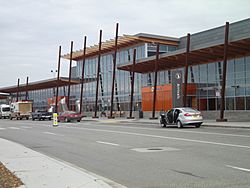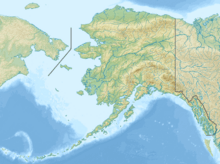Fairbanks International Airport facts for kids
Quick facts for kids
Fairbanks International Airport
|
|||||||||||||||||||||||
|---|---|---|---|---|---|---|---|---|---|---|---|---|---|---|---|---|---|---|---|---|---|---|---|
 |
|||||||||||||||||||||||
 |
|||||||||||||||||||||||
| Summary | |||||||||||||||||||||||
| Airport type | Public | ||||||||||||||||||||||
| Owner | State of Alaska DOT&PF | ||||||||||||||||||||||
| Serves | Fairbanks, Alaska | ||||||||||||||||||||||
| Hub for |
|
||||||||||||||||||||||
| Elevation AMSL | 439 ft / 134 m | ||||||||||||||||||||||
| Coordinates | 64°48′54″N 147°51′23″W / 64.81500°N 147.85639°W | ||||||||||||||||||||||
| Map | |||||||||||||||||||||||
| Runway | |||||||||||||||||||||||
|
|||||||||||||||||||||||
| Statistics | |||||||||||||||||||||||
|
|||||||||||||||||||||||
|
Source: Federal Aviation Administration
Source: Bureau of Transportation |
|||||||||||||||||||||||
Fairbanks International Airport (IATA: FAI, ICAO: PAFA, FAA LID: FAI) is a state-owned public-use airport located three miles (5 km) southwest of the central business district of Fairbanks, a city in the Fairbanks North Star Borough of the United States state of Alaska. Fairbanks is the smallest city in the United States with non-stop service to Europe, as Condor offers weekly flights to Frankfurt during the summer tourist season. Air North is another international airline with flights (to Canada).
Contents
History
Early years
The airport opened in 1951 and took over existing scheduled airline traffic to Fairbanks, which had previously used Ladd Army Airfield. Alaska Airlines used Fairbanks as its main hub in the 1950s, with service to Seattle and Portland as well as intrastate service to Anchorage, Nome and other destinations. By 1967, however, the airline shifted its Alaska hub to Anchorage; its Anchorage-Fairbanks service continues to this day. In the mid-1970s, following the development of the Trans-Alaska Pipeline, Alaska Airlines and Braniff International offered "interchange service" between Fairbanks and Houston via Anchorage, Seattle and Dallas. In 1982, following airline deregulation, Alaska Airlines and American Airlines began a similar interchange service using Boeing 727s.
Pan American World Airways had also served Fairbanks since 1932. The station was originally opened after the acquisition of Pacific International Airways and used for short-haul services to Juneau, Seattle, Ketchikan, Whitehorse and other destinations. Pan Am intended to use Fairbanks as a stop for service to Asia as early as 1931, but initial difficulty in negotiating landing rights with the Soviet Union, followed by the outbreak of World War II, delayed these plans until decades later. Pan Am service to Fairbanks continued through the opening of FAI until 1965, when the Civil Aeronautics Board terminated Pan Am's rights to serve Alaska.
Pan American World Airways eventually used Fairbanks as a stopover for transpacific service from New York and Seattle to Tokyo starting in September 1969. In 1974, Pan Am agreed to transfer its Fairbanks-Seattle service to Western Airlines, and requested that the CAB allow its New York-Tokyo service to be suspended from April 1975. Other carriers such as Japan Airlines and Korean Air began to use Fairbanks as a technical stop for transpacific cargo flights in the late 1970s.
Development since the 2000s
On October 11, 2009, the airport constructed a new terminal and demolished the old terminal which was built in 1948. The new terminal is built around the modern TSA standards. In addition to architectural design and better security, the main terminal now has six jet-bridges (up from the former five). The 2,700m2 of custom unitised curtain wall was designed and supplied by Overgaard Ltd. Hong Kong. The special design incorporated double low-e triple glazing. The new building's footprint is smaller than the old building.
For the 12-month period ending February 28, 2018, the airport had 119,898 aircraft operations, an average of 328 per day: 58% general aviation, 31% air taxi, 9% scheduled commercial, and 2% military. At that time there were 569 aircraft based at this airport: 91% single-engine, 8% multi-engine, <1% jet and <1% helicopter.
Facilities
Terminal
The terminal building, situated on the southwest side of the airport, contains seven gates: two for commuter carriers and five for larger carriers.
Runways
Fairbanks International Airport covers an area of 3,470 acres (1,404 ha) at an elevation of 439 feet (134 m) above mean sea level. It has four runways:
- Runway 2L/20R: 11,800 by 150 feet (3,597 x 46 m), surface: asphalt
- Runway 2R/20L: 6,501 by 100 feet (1,981 x 30 m), surface: asphalt
- Runway 2/20: 2,900 by 75 feet (884 x 23 m), surface: gravel/ski strip
- Runway 2W/20W: 5,400 by 100 feet (1,646 x 30 m), surface: water/winter ski strip
Airlines and destinations
Passenger
| Airlines | Destinations | Refs |
|---|---|---|
| 40-Mile Air | Delta, Healy Lake, Tok |
|
| Air North | Seasonal Charter: Dawson City |
|
| Alaska Airlines | Anchorage, Prudhoe Bay, Seattle/Tacoma |
|
| American Airlines | Seasonal: Chicago–O'Hare (begins June 3, 2021), Dallas/Fort Worth (begins May 6, 2021) |
|
| Condor | Seasonal: Frankfurt |
|
| Delta Air Lines | Seattle/Tacoma Seasonal: Minneapolis/St. Paul |
|
| Everts Air | Anaktuvuk Pass, Arctic Village, Eagle, Fort Yukon, Galena, Huslia, Kaktovik, Kaltag, Nulato, Ruby, Venetie |
|
| Ravn Alaska | Anchorage |
|
| Sun Country Airlines | Seasonal: Minneapolis/St. Paul (begins May 29, 2021) |
|
| United Airlines | Seasonal: Anchorage (begins May 6, 2021), Chicago–O'Hare, Denver (both resume May 6, 2021) |
|
| Warbelow's Air Ventures | Beaver, Central, Circle, Manley Hot Springs, Minto, Rampart, Stevens Village |
|
| Wright Air Service | Allakaket, Anaktuvuk Pass, Arctic Village, Bettles, Birch Creek, Chalkyitsik, Fort Yukon, Galena, Hughes, Huslia, Kaltag, Koyukuk, Lake Minchumina, Nulato, Ruby, Tanana, Venetie |
Cargo
| Airlines | Destinations |
|---|---|
| DHL Aviation | Los Angeles
|
| Empire Airlines | Anchorage |
Statistics
| Carrier | Passengers (arriving and departing) |
|---|---|
| Alaska |
406,000(79.63%)
|
| Delta |
47,310(9.29%)
|
| Wright |
27,580(5.41%)
|
| Horizon |
13,120(2.57%)
|
| Peninsula |
4,790(0.94%)
|
| Other |
10,980(2.15%)
|
| Rank | City | Airport | Passengers | Carriers |
|---|---|---|---|---|
| 1 | Seattle–Tacoma International Airport | 129,350 | Alaska, Delta | |
| 2 | Ted Stevens Anchorage International Airport | 105,680 | Alaska | |
| 3 | Edward G. Pitka Sr. Airport | 3,450 | Everts, Wright | |
| 4 | Fort Yukon Airport | 2,820 | Everts, Wright | |
| 5 | Deadhorse Airport | 2,220 | Alaska | |
| 6 | Anaktuvuk Pass Airport | 1,990 | Everts, Wright | |
| 7 | Huslia Airport | 1,070 | Everts, Wright | |
| 8 | Ralph M. Calhoun Memorial Airport | 950 | Wright | |
| 9 | Allakaket Airport | 860 | Wright | |
| 10 | Ruby Airport | 790 | Everts, Wright |
Images for kids
See also
 In Spanish: Aeropuerto Internacional de Fairbanks para niños
In Spanish: Aeropuerto Internacional de Fairbanks para niños





